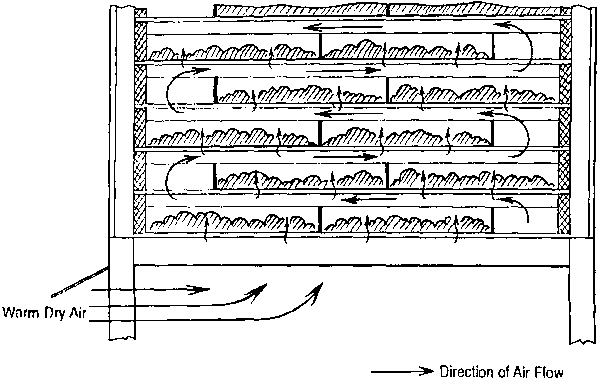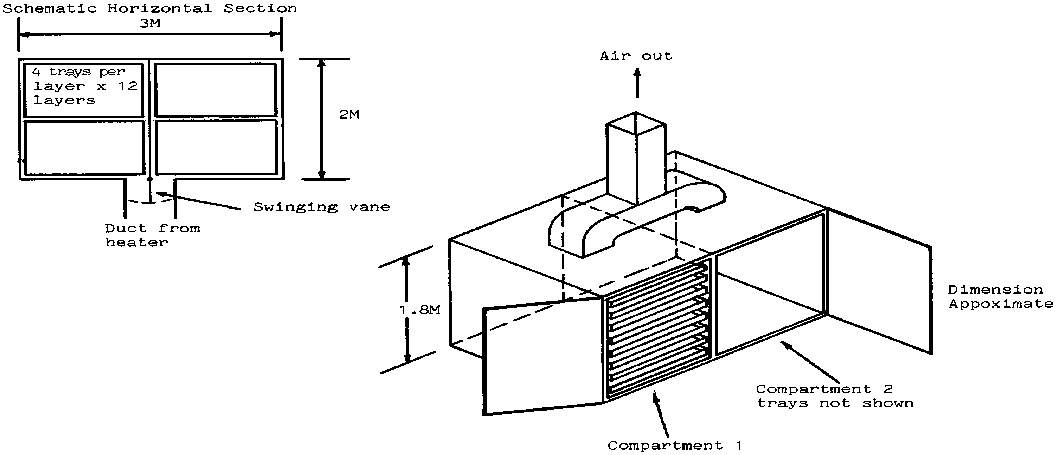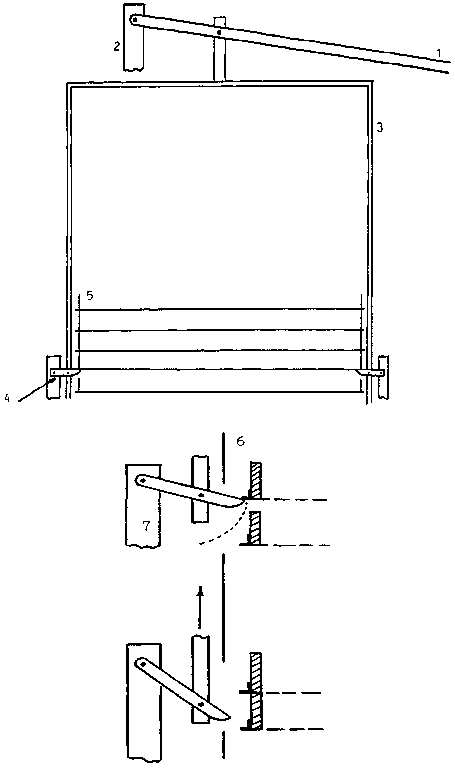How to Build a Tray Dryer: Unterschied zwischen den Versionen
K (Schützte „How to Build a Tray Dryer“ ([Bearbeiten=Nur automatisch bestätigten Benutzern erlauben] (unbeschränkt) [Verschieben=Nur automatisch bestätigten Benutzern erlauben] (unbeschränkt))) |
|||
| (3 dazwischenliegende Versionen desselben Benutzers werden nicht angezeigt) | |||
| Zeile 41: | Zeile 41: | ||
<center> | <center> | ||
| − | [[Image:Tray Dryers01. | + | [[Image:Tray Dryers01.png]]<br /> Figure 1: Basic parts and airflow pattern in an Practical Action dryer |
</center> | </center> | ||
| Zeile 55: | Zeile 55: | ||
</blockquote><center> | </blockquote><center> | ||
| − | [p2.gif [[Image:Tray Dryers02. | + | [p2.gif [[Image:Tray Dryers02.png]]]<br /> Figure 2: A typical double chamber batch dryer |
</center> | </center> | ||
| Zeile 397: | Zeile 397: | ||
==Deeplink:== | ==Deeplink:== | ||
| − | http://en.howtopedia.org/wiki/ | + | http://en.howtopedia.org/wiki/How_to_Build_a_Tray_Dryer |
[[Kategorie:Baustelle]] | [[Kategorie:Baustelle]] | ||
Aktuelle Version vom 4. Juni 2021, 13:23 Uhr
Inhaltsverzeichnis
Übersicht
Übersicht übernommener Howtopedia Artikel, Zum Übersetzten Artikel , zum originale Artikel
Short Description
- Problem: Finding a practical way to dry food
- Idea: To dry food by tray-dryers
- Difficulty: Difficult
- Price Range:
- Material Needeed: Plywood sheets, iron/ wooden frame, fuel
- Geographic Area: Global
- Competencies:
- How Many people? Up to 5 People
- How Long does it take?
Introduction
A range of technologies is used for food drying which include tray and tunnel dryers, spray, roller and freeze dryers. With the exception of tray dryers, none of these are appropriate, in terms of cost and output, for use by small and medium enterprises.
While sun drying on trays or in solar dryers can be considered as tray drying the term is normally applied to small industrial systems with some form of air heater and a fan to pass air over the product being dried. While small tray dryers are available from Europe and the USA, where they are used in pilot plants and Universities, their cost (in excess of £25,000) makes them unaffordable and uneconomic for producers in developing countries.
In the early 1980's ITDG recognised the need for small, controllable, powered tray dryers capable of producing high quality products that could be constructed by engineers in developing countries to a great extent from locally available materials. The required basic development work was carried out and there are now tray dryers, based on the principles developed by ITDG, in some eight countries. The greatest up-take of the technology has been in Latin America where probably over 100 units are now operational. The key point to bear in mind when considering the local construction of such a dryer is to understand the basic principles involved and adapt them to local conditions such as the dimensions of local plywood sheet, common stock steel sizes, social conditions and fuel availability.
The tray dryer family
Practical Action is able to supply information to allow the construction of four types of dryer. In some cases full drawings and a How to Construct and Use manuals are available together with a case study book. Much of this information is in English and Spanish.
Basic principles
The dryers consist of a cabinet containing trays which is connected to a source of air heated by gas, diesel or bio-mass such as rice husk. The air temperature is usually controlled by a thermostat which is normally set between 50 and 70°C. The air enters the bottom of the chamber below the trays and then rises, through the trays of food being dried, and exits from an opening in the top of the chamber. In the Practical Action systems the trays are designed to force the air to follow a longer zigzag route which increases the air/food contact time and thus efficiency. This system also reduces back pressure which means that cheaper, smaller fans can be used.

Figure 1: Basic parts and airflow pattern in an Practical Action dryer
The airflow in a typical system is shown in Figure 1. There are three basic types of tray dryer cabinets; batch, semi-continuous and cross flow dryers. To date Practical Action has only worked with the first two systems.
Batch cabinets are the simplest and cheapest to construct. The cabinet is a simple large wooden box fitted with internal runners to support the trays of food being processed. The trays are loaded into the chamber, the doors closed and heated air is blown through the stack of trays until the entire product is dry. Clearly, as the hot air enters below the bottom tray, this tray will dry first. The last tray to dry is the one at the top of the chamber. The advantages and disadvantages of this system are:
• simple, low cost chamber
• low labour costs - simply load and then unload
• a tendency to over-dry the lower trays
• low efficiency, in terms of furl consumption, in the later stages of drying when most of the trays are dry.
Semi-continuous cabinets were developed by Practical Action in order to overcome some of the disadvantages of the batch system. In a semi-continuous cabinet a lifting mechanism allows all of the trays except the bottom tray to be lifted. It is thus possible to remove the lowest tray as soon as the product is dry. The mechanism then allows all the trays to be lowered (now tray 2 is at the bottom of the stack). This leaves a space at the top of the stack to load a tray of fresh material.
Two types of lifting mechanism are available both of which activate four movable fingers that lift the second tray upwards. One design is operated by a handle which is pulled downwards. The other design, developed in Sri Lanka, has been found more suitable for use by women and here the lifting mechanism is a car screw jack which, on winding up, lifts the four fingers.
The advantages/disadvantages of this system are:
• over-drying is avoided
• product quality is higher
• fuel efficiency is considerably increased
• a higher daily throughput is possible
• the cabinet is however more expensive to construct
• labour costs are higher due to loading and unloading trays at regular intervals
• in order to maximise output 24 hour working is recommended
Typical semi-continuous dryers are shown in Figure 3, which shows the lifting mechanism and the gap above the lowest tray that is ready for removal.
Detail of lifting fingers
1. External lifting mechanism
2. Main lifting lever pivot support
3. Vertical lifting rods
4. Lifting fingers
5. Trays with angle iron edge bearers
6. Inner wall of drying cabinet
7. Lifting finger pivot support
Cross flow chambers. Although ITDG has not, as yet, developed this system it is considered worth mentioning in this short brief. In this chamber the air is blown, through a series of louvers, directly across the trays and then re-circulated over the heater. In the early stages of drying, when a lot of water is being removed, a high proportion of the air is vented to an exit and replaced by fresh air. As drying proceeds the proportion of vented air is reduced. At the end of the drying cycle no air is vented. This system then overcomes the problems associated with batch and semi-continuous cabinets in that:
• labour costs are low as it works like a batch dryer
• all the trays dry at the same rate
• fuel efficiency is maximised.
Cross flow systems are however, technically more complex and require automatic humidity sensors to control the percentage of air vented during the drying cycle.
Technical details
The tea chest dryer
This, the smallest dryer in the range, is designed to allow trials to be carried out, the production of samples to demonstrate to buyers and for basic product costings to be calculated. Due to its low capacity the tea chest dryer is not intended for commercial production but does allow product development at very low cost.
|
Construction: |
plywood walls over wood frame |
|
Dimensions: |
0.5 m3 |
|
Capacity: |
6 trays |
|
Heat source: |
2kw electric fan heater wired with external thermostat so that fan runs continuously |
|
Cost: |
approx. £75 |
|
Capacity: |
approx. 1kg/day |
The large Practical Action semi-continuous
|
Construction: |
plywood walls over angle iron frame |
|
Dimensions: |
cabinet 1.4 x 1.2 x 0.9m |
|
Overall height: |
2.2m |
|
Capacity: |
15 standard trays, each 0.8m2 |
|
Heat source: |
kerosene/diesel indirect heater-blower. Max heat output 60kw. Air output 2800m3 |
|
Fuel consumption: |
0.8 gals/hr at 50°C |
|
Throughput: |
360 kg/24 hrs for herbs |
|
Labour: |
3 workers over 24 hrs |
|
Cost in UK: |
cabinet £2000 |
The small Practical Action semi-continuous
|
Construction: |
Plywood wall over wooden frame |
|
Dimensions: |
Cabinet 1.08 x 0.98 x 0.83m |
|
Overall height: |
1.9m |
|
Capacity: |
13 trays, useful area per tray 0.53m2 |
|
Heat source: |
Direct gas heater/blower (max output 25kw and 470m3 air/hr) |
|
Fuel consumption: |
0.5lbs per hour at 50°C |
|
Throughput: |
120 kg of herbs per 24 hour cycle |
|
Labour: |
3 workers on shift |
|
Cost (in UK): |
Cabinet £600 Heater £300 |
The Anagi dryer
This semi-continuous dryer was developed by IT-Sri Lanka (now ITDG South Asia) and is the only design that uses biomass (rice husk) as a source of heat and does not require electricity. Tray lifting is by a mechanical car jack under the cabinet. Contamination of the product is avoided by use of a heat exchanger. As the dryer depends on natural convection of air (rather than fans) its capacity is lower than the powered dryers. Its capital and running costs are however very low
|
Construction: |
Timber walls over angle iron frame |
|
Dimensions: |
4ft x 2ft 8" x 7ft |
|
Throughput: |
70-80 kg cashew nuts/day |
|
No of trays: |
6 |
|
Fuel: |
saw dust or rice husk |
|
Fuel consumption: |
30 kg/day |
|
Cost: |
£260 in Sri Lanka |
Double chamber batch dryer
|
Construction: |
Plywood over wood frame |
|
Dimensions: |
Cabinet 1.8 x 2.0 x 3.0m |
|
Capacity: |
28 trays. Useful tray area 1.2m2 |
|
Heat source: |
Indirect diesel heater blower, max 60 kw heat |
|
Throughput: |
240 kg per 24 hours |
|
Labour: |
A few hours to load and unload |
|
Cost (in UK): |
Cabinet £500 Heater £1500 |
Economic considerations. During processing any food value is added and the value added per kg processed must be sufficient to cover all the costs involved such as labour, fuel, rent and depreciation costs. In general very little value is added to low value foods such as cereals and root crops. For this reason it is only economic to dry such commodities in very large plants. Considerable value can however be added to certain fruits, herbs, nuts, spices and vegetables such as mushroom or asparagus. These are the foods most commonly processed by small and medium drying enterprises
Drying data. Most of the experiences to date have been with drying herbs and fruits. Typical drying times for herbs in semi-continuous dryer at 55°C are 4 hours prior to the removal of the first tray, after which a tray of dry herbs can be removed every 15 minutes. Each tray removed is replaced with a tray containing 5kg of fresh herbs. In the case of sliced fruits however it requires 8 to 10 hours to dry the first tray. Thereafter, trays can be removed and loaded every 30-45 minutes. Drying data and production costs for a wider range of products are currently being investigated and ITDG can access additional information through its network of development organisations.
Organisations and enterprises seriously interested in developing dried food products may be interested to know that a test dryer has been designed that can be locally constructed. This allows drying rate curves for a given food to be quickly and cheaply prepared. Such information is invaluable to those involved in equipment design and new product development. The unit consists of one foot box heated (in the same way as the tea-chest dryer) by a domestic hair dryer. The tray of food being investigated is suspended from an electronic balance reading to 0.1g. The weight of product is then simply plotted against time as it dries. Drawings are available from ITDG.
References and further reading
This Howtopedia entry was derived from the Practical Action Technical Brief Tray Dryers.
To look at the original document follow this link:
http://www.practicalaction.org/?id=technical_briefs_food_processing
Drying of Foods, Practical Action Technical Brief
Drying Technologies, Practical Action Technical Brief
Anagi Tray Dryer, Practical Action Technical Brief
Solar Drying, Practical Action Technical Brief
Drying Food for Profit: A Guide for Small Businesses Barrie Axtell, ITDG Publishing, 2002
Producing Solar Dried Fruit and Vegetables for Micro- and Small-scale Rural Enterprise Development Natural Resources Institute, 1996
Related Articles
- How to Preserve Food with Small Scale Drying Technologies
- How to Preserve Food by Drying
- How to Use Sun Power
- How to Make Chocolate
- How to Preserve Tomato
- How to Preserve Food with a Solar Dryer
- How to Process Spice
- How to Process Turmeric
Useful contacts
Practical Action
The Schumacher Centre for Technology & Development, Bourton on Dunsmore, RUGBY, CV23 9QZ, United Kingdom.
Tel.: +44 (0) 1926 634400, Fax: +44 (0) 1926 634401
e-mail:practicalaction@practicalaction.org.uk web:www.practicalaction.org

Our country offices will be able to put you in touch with tray drier users in their regions, addresses are given below:
Practical Action South Asia
5 Lionel Edirisinghe Mawatha, Kirulapone, Colombo 5, Sri Lanka
Tel: +94 11 2829412, Fax: +94 11 2856188
Practical Action Latin America
Casilla postal 18-0620, Lima 18, Perú, Tel: +511 446 7324, Fax: +511 446 6621


